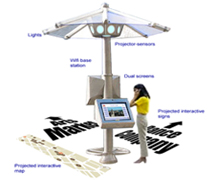
Jan. 4, 2011
Wired Hospitality 2.0: New Info Rich Environments
Hotels and restaurants are adapting spaces and furnishings to fit guests' new technology needs and thereby find new profits.
Hospitality spaces are being designed to fit viewing conditions for guests' 4 screen displays: mobile, tablet, desktop, and cinema (see Fairmount Hotel media room above). Hotel lobbies, meeting rooms, concierge lounges, and bars are adapting a range of seating, lighting, and acoustics for their use. This creates multiple zones, public to semi-private, in one space often to function for both work and play. Also these interactive screens are generating new applications in guest relationship, amenities, and food service, such as for menu ordering and guest feedback.
British restaurants and bars have installed small pico interactive digital projectors coupled with sensors for menu orders and games on tabletops. www.projectorreviews.com CDG is investigating their use for client KFC's new urban prototype. These projected "soft smart screens" (see CDG article on natural user interfaces). are cheaper than hardware screens and easier on the eyes.

Dec. 14, 2011
Tangible User Interface (TUI) will change Learning, Hotel, and Retail Spaces
CDG is designing a new San Francisco State University student multi-purpose room that employs TUI for a large scale 9' x 16' interactive display.
TUI is the near future of interface design, a jump away from what Brett VIctor calls pictures under glass: ABriefRantOnTheFutureOfInteractionDesign. Based on environmental ambient intelligence research where user behavior in a space controls the technology by sensors. TUI is rapidly developing because of the versatile $150 Kinect sensor from Microsoft and its open development program that is generating many cheap, easy applications.
The student room application will use what CDG's Doug Cain calls a soft smart screen: an interactive display projected on a wall, tabletop, or floor controlled by hand or body gestures. The display is created by a digital projector with a Kinect sensor installed in the ceiling away from tampering. This same installation can create large, immersive, compelling environments with multiple applications. Schools can cheaply transform lunchroom and corridor walls into eye-popping portals to whole internet universes. Hotels can energize their spaces with a wide range of interactivity. Retail stores can show customers inside projected clothes or whole product environments. These same sensors can also analyze shopper circulation and behavior for ROI data.

Nov. 16, 2011
Creating an Arts-Tech Urban Plan
CDG is using creative placemaking strategies including environmental branding to establish a San Francisco neighborhood as a hybrid tech and arts cultural district, job incubator, and tourist destination.
Creative placemaking is an urban planning concept to nuture an area's character around arts and culture that spurs business vitality and creativity. See CreativePlacemaking. This neighborhood already is an unusual cluster of culture and edgy tech forming the city's highest concentration of creative studios, organizations, and businesses. Yet the area lacks broad awareness of its intrinsic cultural identity and resources.
Placemaking strategies include fostering a crowd-sourced district name, installing a permanent Culture Walk with signs to creative spaces, promoting an arts and tech festival, establishing a creative tech job training program, and transforminging benches and bus stops into public tech art.
Establishing the area as an identifiable tech and arts cultural district will be a tipping point to generate multiple economic returns from increased local pride, local resource usage, and broader regional awareness that attracts more cultural consumers and revenue. For more details ee the project page.
blogs
advanceImagine.comLeading edge tech, culture, and social trends.
BigFoodThink.comThe future of food in farming, home, and hospitality.

Doug Cain's speech at Cal. Assn. of College Stores

Doug Cain's lecture at San Francisco State U.
CDG designs architecture for new food facility

